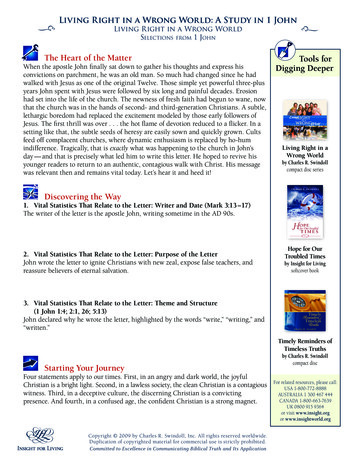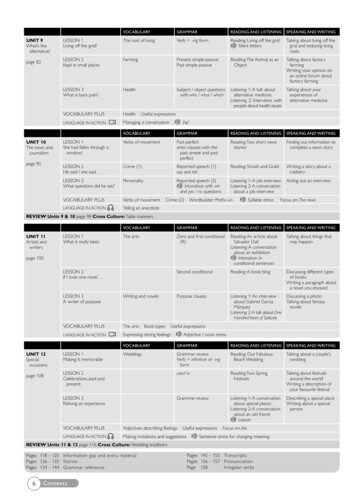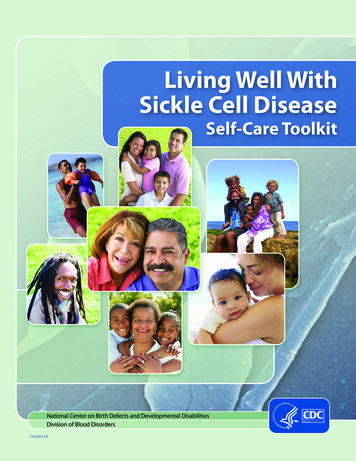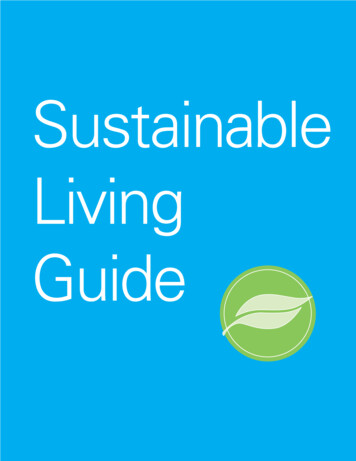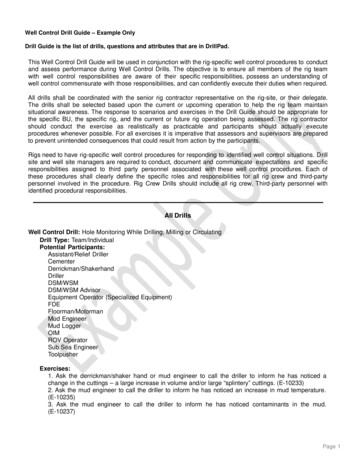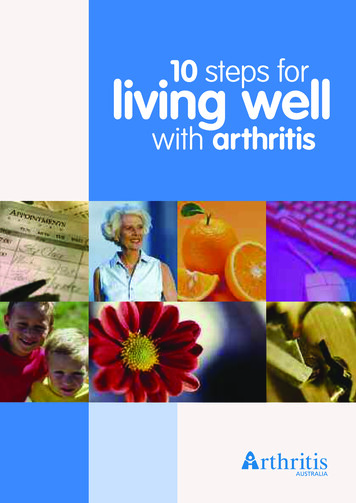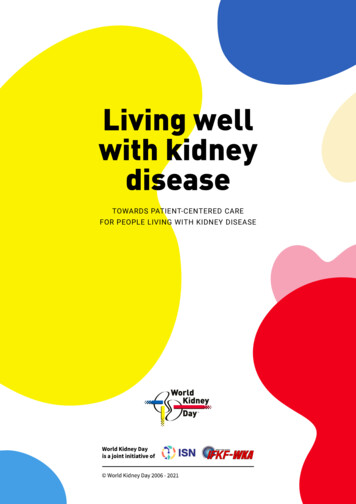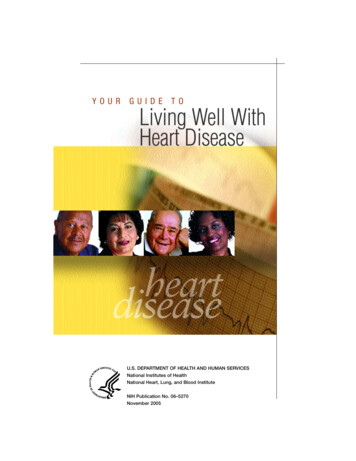
Transcription
YOURGUIDE TOLiving Well WithHeart DiseaseU.S. DEPARTMENT OF HEALTH AND HUMAN SERVICESNational Institutes of HealthNational Heart, Lung, and Blood InstituteNIH Publication No. 06–5270November 2005
Written by: Marian SandmaierU.S. DEPARTMENT OF HEALTH AND HUMAN SERVICESNational Institutes of HealthNational Heart, Lung, and Blood Institute
ContentsIntroduction . . . . . . . . . . . . . . . . . . . . . . . . . . . . . . . . . . . . . . . . . . . . . . . . . . . . . 1Heart Disease: A Wakeup Call . . . . . . . . . . . . . . . . . . . . . . . . . . . . . . . . . . . . . 2What Is Heart Disease? . . . . . . . . . . . . . . . . . . . . . . . . . . . . . . . . . . . . . . . . . . . 4Getting Tested for Heart Disease . . . . . . . . . . . . . . . . . . . . . . . . . . . . . . . . . . . 7Controlling Your Risk Factors . . . . . . . . . . . . . . . . . . . . . . . . . . . . . . . . . . . . . 10You and Your Doctor: A Healthy Partnership . . . . . . . . . . . . . . . . . 12Major Risk Factors . . . . . . . . . . . . . . . . . . . . . . . . . . . . . . . . . . . . 13Smoking . . . . . . . . . . . . . . . . . . . . . . . . . . . . . . . . . . . . . . . . . . 13High Blood Pressure . . . . . . . . . . . . . . . . . . . . . . . . . . . . . . . . . 14High Blood Cholesterol . . . . . . . . . . . . . . . . . . . . . . . . . . . . . . . 18Overweight and Obesity . . . . . . . . . . . . . . . . . . . . . . . . . . . . . . 23Physical Inactivity. . . . . . . . . . . . . . . . . . . . . . . . . . . . . . . . . . . . 26Diabetes . . . . . . . . . . . . . . . . . . . . . . . . . . . . . . . . . . . . . . . . . . 27What Else Affects Heart Disease? . . . . . . . . . . . . . . . . . . . . . . . . . . . . . . . . . 31Stress . . . . . . . . . . . . . . . . . . . . . . . . . . . . . . . . . . . . . . . . . . . . 31Alcohol . . . . . . . . . . . . . . . . . . . . . . . . . . . . . . . . . . . . . . . . . . . . 31Sleep Apnea. . . . . . . . . . . . . . . . . . . . . . . . . . . . . . . . . . . . . . . . . 32Menopausal Hormone Therapy . . . . . . . . . . . . . . . . . . . . . . . . . . . 33C-Reactive Protein . . . . . . . . . . . . . . . . . . . . . . . . . . . . . . . . . . . . 33Treatments for Heart Disease . . . . . . . . . . . . . . . . . . . . . . . . . . . . . . . . . . . . . 34Medications . . . . . . . . . . . . . . . . . . . . . . . . . . . . . . . . . . . . . . . . . 34Managing Angina . . . . . . . . . . . . . . . . . . . . . . . . . . . . . . . . . . . . . 38Procedures. . . . . . . . . . . . . . . . . . . . . . . . . . . . . . . . . . . . . . . . . . 41Coronary Angioplasty, or “Balloon” Angioplasty . . . . . . . . . . . . . . 42Plaque Removal . . . . . . . . . . . . . . . . . . . . . . . . . . . . . . . . . . . . 42Stent Placement . . . . . . . . . . . . . . . . . . . . . . . . . . . . . . . . . . . . 42Coronary Bypass Surgery . . . . . . . . . . . . . . . . . . . . . . . . . . . . . 44Getting Help for a Heart Attack. . . . . . . . . . . . . . . . . . . . . . . . . . . . . . . . . . . . 46Know the Warning Signs. . . . . . . . . . . . . . . . . . . . . . . . . . . . . . . . 46Get Help Quickly . . . . . . . . . . . . . . . . . . . . . . . . . . . . . . . . . . . . . 46Plan Ahead. . . . . . . . . . . . . . . . . . . . . . . . . . . . . . . . . . . . . . . . . . 49
Recovering Well: Life After a Heart Attack or Heart Procedure. . . . . . . . 51Your First Weeks at Home. . . . . . . . . . . . . . . . . . . . . . . . . . . . . . . 52Cardiac Rehabilitation . . . . . . . . . . . . . . . . . . . . . . . . . . . . . . . . . . 55Getting Started . . . . . . . . . . . . . . . . . . . . . . . . . . . . . . . . . . . . . 55How To Choose a Cardiac Rehab Program . . . . . . . . . . . . . . . . 56What You’ll Do in a Cardiac Rehab Program. . . . . . . . . . . . . . . . 56Getting the Most Out of Cardiac Rehab . . . . . . . . . . . . . . . . . . . 57Getting Your Life Back . . . . . . . . . . . . . . . . . . . . . . . . . . . . . . . . . 59Coping With Your Feelings . . . . . . . . . . . . . . . . . . . . . . . . . . . . . . 60Caring for Your Heart . . . . . . . . . . . . . . . . . . . . . . . . . . . . . . . . . . . . . . . . . . . . 63To Learn More . . . . . . . . . . . . . . . . . . . . . . . . . . . . . . . . . . . . . . . . . . . . . . . . . . 64
1IntroductionChances are, you’re reading this book because you or someone closeto you has heart disease. Perhaps your doctor has recently told youthat you have a heart condition, and you’re looking for informationon how to take good care of yourself. Perhaps you’ve known aboutyour condition for some time and are interested in the latest knowledge on treatment and self-care. Perhaps you’ve recently had a heartattack or heart surgery and want some guidance on making the bestpossible recovery.This book will address all of these concerns. It is a step-by-stepguide to helping people with heart disease make decisions that willprotect and improve their heart health. It will give you informationabout lifestyle habits, medicines, and other treatments that canlessen your chances of having a heart attack—either a first attack ora repeat one. If you have already had a heart attack or have undergone a heart procedure, you will find guidance on how to recoverwell, both physically and emotionally.But this book is not just about preventing and treating pro b l e m s . Itis also about how to live well with heart disease. It will help you tomake decisions that allow you tolive as fully, healthfully, andenjoyably as possible, evenas you cope with thedemands of your heartcondition. As you readthis book, you will findthat caring for yourh e a rt and caringfor yourself aredeeply intertwined. To findout why andhow, read on.
2Heart Disease:A Wakeup CallIf you have heart disease, you may understandably hope that it’sonly a temporary ailment, one that can be cured with medicine orsurgery. But heart disease is a lifelong condition: Once you have it,you’ll always have it. It’s true that procedures such as angioplastyand bypass surgery can help blood and oxygen flow more easilythrough the coronary arteries that lead to the heart. But the arteriesremain damaged, which means that you’re more likely to havea heart attack. It is sobering, yet important, to realize that thecondition of your blood vessels will steadily worsen unless you makechanges in your daily habits. Many people die of complicationsfrom heart disease, or become permanently disabled. That’s whyit is so vital to take action to control this serious condition.The good news is that you can control heart disease. There is muchyou can do to manage your heart condition, reduce your risk of afirst or repeat heart attack, and improve your chances of living along, rewarding life. The sooner you get started, the better yourchances of avoiding further heart problems, feeling better, and staying well. So use this handbook to find out more about your ownheart condition and what you can do to improve it. You have thepower to make a positive difference in your heart health—and youcan start making that difference today.
3WILBUR““M AC”MCCOTT RYMy real wakeup call came about 2 weeks aftermy heart bypass operation. The doctor said hedid all he could to save my life and the restwas up to me. We l l , those words shook me up.I knew exactly what he meant: lose theweight, quit smoking, exercise more, andmake changes to my diet. So I took it very,very seriously. I lost 70 lbs. I am walking2 miles three times a week in a programat the mall.”
4What Is Heart Disease?Coronary heart disease is the main form of heart disease. It occurs whenthe coronary arteries, which supply blood to the heart muscle, becomehardened and narrowed due to a buildup of plaque on the arteries’ innerwalls. Plaque is the accumulation of cholesterol, fat, and other substances. As plaque continues to build up in the arteries, blood flow tothe heart is reduced.Coronary heart disease—often simply called heart disease—can lead toa heart attack. A heart attack happens when a cholesterol-rich plaquebursts and releases its contents into the bloodstream. This causes ablood clot to form over the plaque, totally blocking blood flow throughthe artery and preventing vital oxygen and nutrients from getting to theheart. A heart attack can cause permanent damage to the heart muscle.Heart disease includes a number of other serious conditions, including:Angina. More than 6 million Americans live with angina, which is chestpain or discomfort that occurs when the heart muscle is not gettingenough blood. The inadequate blood flow is caused by narrowed coronary arteries, due to an accumulation of plaque. A bout of angina isnot a heart attack, but it means that you’re more likely to have a heartattack than someone who doesn’t have angina. There are two kinds ofangina:Stable angina has a recognizable pattern. It may feel like pressureor a squeezing pain in your chest. The pain may also occur in yourshoulders, arms, neck, jaw, or back. It may also feel like indigestion.Stable angina pain is generally brought on by some kind of exertion orstrain (such as climbing stairs or experiencing emotional stress), and it isusually relieved by rest or medicine.Unstable angina is more serious than stable angina. Occurring at anytime, unstable angina often reflects a change in a previously stable
5pattern of angina. Episodes of unstable angina are usually morefrequent, painful, and longer lasting than bouts of stable angina, anda re less often relieved by rest or medicine. Unstable angina is a signthat you may have a heart attack very soon. The symptoms are thesame as if you are having a heart attack. (See page 46 for heartattack warning signs.) If you have any of these symptoms, youshould call 9–1–1 right away so that you can get immediate treatment.Congestive heart failure. Congestive heart failure is a life-threateningcondition in which the heart cannot pump enough blood to supplythe body’s needs. Affecting nearly 5 million Americans, heart failureoccurs when excess fluid collects in the body as a result of heartweakness or injury. This condition leads to a buildup of fluid in thelungs, causing swelling of the feet, tiredness, weakness, and breathing difficulties.High blood pressure is the leading cause of congestive heart failurein the United States. Heart disease and diabetes are also majorunderlying causes of heart failure. People who have had a heartattack are at high risk of developing this condition.Arrhythmias.Arrhythmias are problems that affect theelectrical system ofthe heart muscle, producing abnormal heartrhythms. Many factorscan contribute to arrhythmias, including heart disease,high blood pressure, diabetes,smoking, heavy alcohol use,an electrolyte imbalance, drug abuse,and stress.Certainmedicines,
6dietary supplements, and herbal remedies also cause arrhythmias insome people.A common type of arrhythmia is called atrial fibrillation, a disord e ra ffecting 2.2 million Americans. It is more common in older peopleand those with certain inborn heart pro b l e m s . Atrial fibrillationoccurs when the heart ’s two upper chambers (the atria) quiver insteadof beating norm a l l y. Blood isn’t pumped completely out of thesechambers, making it more likely to pool and clot. If a clot leaves theh e a rt and becomes lodged in an artery in the brain, a stroke results.About 15 percent of strokes occur in people with atrial fibrillation.Another type of arrhythmia called ventricular fibrillation occurswhen the lower heart chambers (the ventricles) quiver, preventingthe heart from effectively pumping blood. This is the most dangerous type of heart rhythm disturbance. To prevent collapse andsudden cardiac death, it is vital to get immediate emergency medicalhelp for ventricular fibrillation.
7Getting Tested for HeartDiseaseYou may be reading this book because you thinkyou might have heart disease but aren’t yet sure.Keep in mind that heart disease doesn’t alwaysannounce itself with symptoms. That means youcould have heart disease and still feel perfectlyfine. The best course is to talk with yourdoctor about your personal degree of heartdisease risk and about whether getting testedis a good idea.Most screening tests for heart disease aredone outside of the body and are painless.After taking a careful medical history anddoing a physical examination, your doctor maygive you one or more of the following tests:Electrocardiogram (ECG or EKG) makes agraph of the heart’s electrical activity as itbeats. This test can show abnormal heartbeats, heart muscle damage, blood flowproblems in the coronary arteries, and heartenlargement.S t ress test (or treadmill test or exercise ECG)records the heart ’s electrical activity duringe x e rcise, usually on a treadmill or exercise bike.If you are unable to exercise due to arthritis oranother health condition, a stress test can bedone without exerc i s e . Instead, you can takea medicine that increases blood flow to theh e a rt muscle and shows whether there are anyp roblems in that flow.
8Nuclear scan (or thallium stress test) shows the working of the heartmuscle as blood flows through the heart. A small amount of radioactive material is injected into a vein, usually in the arm, and a camerare c o rds how much is taken up by the heart muscle.Echocardiography changes sound waves into pictures that show theheart’s size, shape, and movement. The sound waves also can be usedto see how much blood is pumped out by the heart when it contracts.Coronary angiography (or angiogram or arteriography) shows anx ray of blood flow problems and blockages in the coronary arteries.A thin, flexible tube called a catheter is threaded through an arteryof an arm or leg up into the heart. A dye is then injected into thetube, allowing the heart and blood vessels to be filmed as the heartpumps. The picture is called an angiogram or arteriogram.Ventriculogram is frequently a part of the x-ray dye test describedbefore. It is used to get a picture of the heart’s main pumping chamber, typically the left ventricle.Intracoronary ultrasound uses a catheter that measures blood flow.It creates a picture of the coronary arteries that shows the thicknessand other features of the artery wall. This lets the doctor see bloodflow and any blockages.In addition, several new, highly sensitivescreening tests have been developed.Ask your doctor about these tests:Carotid doppler ultrasound usessound waves to detect blockages and narrowing of thecarotid artery in the neck,both of which can signal anincreased risk for heartattack or stroke.Electron-beam computedtomography is a superfastscan that provides a snapshot of the calcium buildupin your coronary arteries.
9Should You Get a Heart Testat the Local Mall?Recent media attention has raised public interest in the “total bodyscan” or “virtual scan,” now offered at many malls around the country. This is a computed tomography (CT) scan that quickly screensfor a number of diseases, including heart disease. Is the total bodyscan a good way to find out whether you have a heart condition?Probably not. One of the problems with many mall-based bodyscans is that they use types of CT scanners known as spiral orhelical. Neither of these types of scanners has proven effectivefor heart imaging. Furthermore, some spiral scanners transmitrelatively high doses of radiation.A CT heart scan should be performed using the U.S. Food andDrug Administration-approved, electron-beam CT scanner, whichis lower in radiation. This type of scanner is available primarily inhospitals and other traditional health care settings. Getting tested ina medical setting also allows your doctor to interpret the results foryou and evaluate your need for further testing.Heart TestIt can pick up heart disease before you feel any symptoms. Whilepromising, this test is not foolproof and requires careful evaluationby your doctor. (See “Should You Get a Heart Test at Your LocalMall?” above.)Magnetic resonance imaging (MRI) is a scan using magnets andcomputers to create high-quality images of the heart’s stru c t u reand functioning. It is often used to evaluate congenital heart disease.The test can also detect severe blockages in coronary arteries inpeople who are having unstable angina or a heart attack, therebyallowing immediate treatment to restore blood flow to the heart.
10Controlling Your Risk FactorsIf you have heart disease, you may wonder why you have it. Theanswer is that many personal characteristics, health conditions, andlifestyle habits can contribute to heart disease. These are calledrisk factors.But risk factors do more than simply contribute to heart problems.They also increase the chances that existing heart disease willworsen. Since you already have heart disease, it is very importantto find out about all of your risk factors and take active steps tocontrol them.Certain risk factors, such as getting older, can’t be changed. Startingat age 45, a man’s risk of heart disease begins to rise, while a woman’srisk begins to increase at age 55. Family history of early heartdisease is another risk factor that can’t be changed. If your fatheror brother had a heart attack before age 55, or if your mother orsister had one before age 65, you are more likely to develop heartdisease yourself.While certain risk factors can’t be changed, it’s important to realizethat you do have control over many others. Regardless of your ageor family history, or how serious your heart disease is, you can takesteps to reduce your risk of a first or repeat heart attack. You canalso manage other problems associated with heart disease, such asangina, heart failure, and arrhythmias.It may be tempting to believe that doing just one healthy thing willbe enough to control heart disease. For example, you may hope thatif you walk or swim regularly, you can still eat a lot of fatty foodsand stay safe. Not so. To reduce your risk of a heart attack andother complications, it is vital to make changes that address eachrisk factor you have. You can make the changes gradually, one ata time. But making them is very important.
11ROS ARIO“MOJICAI recently had a physical and was surprised tohear my doctor say I have several risk factorsfor heart disease. Around the same time, I sawa TV special about heart disease and itscomplications and risks, so it really hit home.I’m concerned about this and want to changeit. I have to loseweight and reducemy cholesterol.This is just thebeginning of along battle andI know it won’t beeasy, but I knowI have to do it.”
12While each risk factor may contribute to worsened heart disease,the more risk factors you have, the higher your risk. That’s becauserisk factors tend to “gang up” and worsen each other’s effects. Forexample, if you have high blood cholesterol and diabetes, your heartattack risk increases enormously. The message is clear: If you haveheart disease, you must take immediate steps to reduce your risk oflife-threatening medical problems. It’s your heart and you haveeverything to gain from taking good care of it.You and Your Doctor: A Healthy PartnershipYour doctor can be an important partner in helping you manageh e a rt disease. He or she may already have spoken with you aboutyour heart disease risk factors, but if not, be sure to ask about how tocontrol all of them to help prevent future pro b l e m s . H e re are sometips for establishing good, clear communication with your doctor.Speak up. Tell your doctor that you want to keep your heart diseasefrom getting worse and would like help in achieving that goal. Askquestions about your chances of having a first heart attack or arepeat heart attack, your risk of other heart complications, and waysto lower those risks. If you haven’t done so already, ask for teststhat will determine your personal risk factors.Be open. When your doctor asks you questions, answer them ashonestly and fully as you can. While certaintopics may seem quite personal, discussingthem openly can help your doctor workwith you more effectively tomanage your heart condition.Keep it simple. If you don’tunderstand something yourdoctor says, ask for an explanation inplain language. Be especially sure youunderstand how to make thelifestyle changes your doctorrecommends, as well aswhy and how to takeeach medication you’regiven. If you’re worried about understanding what the
13doctor says, or if you have trouble hearing, bring a friend or relativewith you to your appointment. You may want to ask that person towrite down the doctor’s instructions for you.Major Risk FactorsA strong partnership with your doctor is an important first step inmanaging heart disease. But to make a lasting difference, you’ll alsoneed to learn more about the kinds of habits and conditions thatcan worsen heart disease and what you can do about them. Whatfollows is a guide to major risk factors for heart disease, heartattack, and other heart problems, and steps you can take to controlor eliminate them.SmokingSmoking is the “leading cause of preventable death and disease inthe United States,” according to the Centers for Disease Control andPrevention. If you have heart disease and continue to smoke, yourrisk of having a heart attack is very high. If you live or work withothers, your “secondhand” smoke can cause them numerous healthproblems, including a higher risk of heart attack—even if they don’tsmoke themselves. By the same token, if you have heart disease andlive or work with someone who smokes, your own risk of heartattack goes up considerably.Smoking puts stress on the heart in many ways. The nicotine inc i g a rettes constricts the coronary arteries, which raises blood pressureand forces the heart to work harder. Smoking also raises carbonmonoxide levels and reduces oxygen levels in the blood. It’s a doublewhammy: Smoking both increases the heart ’s need for oxygen andrestricts the amount of oxygen it receives.There is simply no safe way to smoke. Low-tar and low-nicotinecigarettes do not lessen the risks of a heart attack. The only safeand healthful course is not to smoke at all.The good news is that quitting smoking will immediately and significantly reduce your risk of further heart disease complications. After afew days, once nicotine and carbon monoxide are cleared from yourbody, your blood pressure will go down and the levels of oxygen andcarbon monoxide in your blood can return to normal. Within 1 yearafter quitting, your blood flow and breathing will be improved andyour coughing and shortness of breath will be reduced.
14Some people prefer to quit on their own, while others find groupsupport helpful. A number of free or low-cost programs are available to help people stop smoking. They include classes offered bylocal chapters of the American Lung Association and the AmericanCancer Society. Other low-cost programs can be found throughhospitals, health maintenance organizations (HMOs), workplaces,and community groups.Also consider using a medicine that can help you stay off cigarettes.Some medications contain very small amounts of nicotine, which canhelp to lessen the urge to smoke. They include nicotine gum (available over the counter), a nicotine patch (available over the counterand by prescription), a nicotine inhaler (by prescription only), and anicotine nasal spray (by prescription only). Another quitting aid isBupropion SR, a medicine that contains no nicotine but reduces thecraving for cigarettes. It is available only by prescription. While allof these medications can help people quit smoking, they are not safefor everyone. Talk with your doctor about whether you should tryany of these medicines.High Blood PressureHigh blood pressure, also known as hypertension, is another majorrisk factor for heart disease and heart attack. For those who alreadyhave heart disease, high blood pressure raises heart attack risk evenhigher. Hypertension also raises the risks of stroke, congestive heartfailure, and kidney disease.Blood pressure is the amount of force exerted by the blood againstthe walls of the arteries. Everyone has to have some blood pressure,so that blood can get to all of the body’s organs. Blood pressure isusually expressed as two numbers, such as 120/80, and is measuredin millimeters of mercury (mmHg).The first number is the systolic blood pressure, the amount of forceproduced when the heart beats. The second number, or diastolicblood pressure, is the pressure that exists in the arteries betweenheartbeats. The higher your blood pressure, the harder your hearthas to work, and the more “wear and tear” on your blood vessels.High blood pressure is often called the silent killer because it usuallydoesn’t cause symptoms. According to a national survey, two-thirdsof people with high blood pressure do not have it under control.
15Blood Pressure:How High Is High?Your blood pressure category is determined by the higher numberof either your systolic or your diastolic measurement. For example,if your systolic number is 115 but your diastolic number is 85, yourcategory is prehypertension.SystolicDiastolicNormal blood pressureLess than 120andLess than 80Prehypertension120–139or80–89High blood pressure140 or higheror90 or higherBlood PressureBut you can take action to control high blood pressure, and therebyavoid many life-threatening disorders.Your health care provider should check your blood pressure onseveral different days before deciding whether it is too high. Bloodpressure is considered high when it stays at or above 140/90 over aperiod of time. However, if you have diabetes, it is important tokeep your blood pressure below 130/80.For those with heart disease, it is especially important to controlblood pressure to reduce the risks of stroke and heart attack. Evenif you don’t have high blood pressure, it is important to avoiddeveloping prehypertension, a condition that increases your riskfor high blood pressure.
16Be aware, too, that a high systolic blood pressure level (first number)is dangerous. If your systolic blood pressure is 140 or higher (or130 or higher if you have diabetes), you are more likely to developheart disease complications and other problems even if yourdiastolic blood pressure (second number) is in the normal range.High systolic blood pressure is high blood pressure. If you have thiscondition, you will need to take steps to control it. High bloodpressure can be controlled in two ways: by changing your lifestyleand by taking medication.Changing your lifestyle. If your blood pressure is not too high, youmay be able to control it entirely by losing weight if you are overweight, getting regular physical activity, limiting the salt in yourfood, cutting down on alcohol, and changing your eating habits.A special eating plan called DASH can help to lower blood pressure.DASH stands for Dietary Approaches to Stop Hypertension. TheDASH eating plan emphasizes fruits, vegetables, whole-grain foods,and low-fat dairy products. It is rich in magnesium, potassium, calcium, protein, and fiber, but low in saturated fat, trans fat, total fat,and cholesterol. (Trans fat is a harmful type of dietary fat thatforms when vegetable oil is hardened.) The diet also limits red meat,sweets, and sugar-containing beverages.If you follow the DASH eatingplan and also consume lesssodium, you are likely toreduce your blood pressureeven more . Sodium is a substance that affects blood pressure. It is the main ingredientin salt and is found in manyprocessed foods,such as soups,conveniencemeals, somebreads and cereals, and saltedsnacks. Formore on theDASH eating
17Sudden Symptoms:Learn the Warning Signsof a StrokeA stroke is a loss of blood flow to the brain that causes braintissue to die. Stroke is a medical emergency. If you or someoneyou know has a stroke, it is important to recognize the symptomsso that you can get to a hospital quickly. Getting treatment within60 minutes can prevent disability. The chief warning signs of astroke are: Sudden numbness or weakness of the face, arm, or leg(especially on one side of the body).Sudden confusion, trouble speaking, or understanding speech.Sudden trouble seeing in one or both eyes.Sudden trouble walking, dizziness, or loss of balance orcoordination.A sudden, severe headache with no known cause.If you think someone might be having a stroke, call 9–1–1immediately. Also, be sure that family members and others closeto you know the warning signs of stroke. Give them a copy ofthis list.Ask them to call 9–1–1 right away if you or someone else showsany signs of a stroke.Signs of aStroke
18plan and other changes you can make to lower and prevent highblood pressure, see the National Heart, Lung, and Blood Institute’s(NHLBI’s) Web page, Your Guide to Lowering High Blood Pressure,which is listed in the “To Learn More” section of this guidebook.Taking medication. If your blood pressure remains high evenafter you make lifestyle changes, your doctor will probably prescribemedicine. Depending on your health needs, your doctor may prescribe medication from the start, along with changes in your livinghabits. One recent study found that diuretics (water pills) work better than newer drugs to treat high blood pressure in many people.Other research shows that using a diuretic can reduce the risk ofdeath from heart and blood vessel diseases, especially among peoplewith diabetes. Talk with your doctor about making one of yourhigh blood pressure medications a diuretic.Keep in mind that lifestyle changes will help the medicine workmore effectively. In fact, if you are successful with the changes youmake in your daily habits, you may be able to gradually reduce theamount of medication you take.Taking medicine to lower blood pressure can reduce your risk ofheart attack, stroke, congestive heart failure, and kidney disease.Be sure to take your blood pressure medicine exactly as yourdoctor has prescribed it. Before you leave your physician’s office,make sure you understand the amount of medicine yo
first or repeat heart attack, and improve your chances of living a long, rewarding life. The sooner you get started, the better your chances of avoiding further heart problems, feeling better, and stay-ing well. So use this handbook to find out more about your own heart


